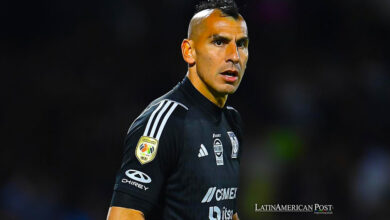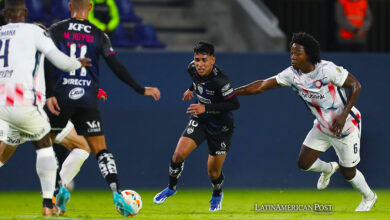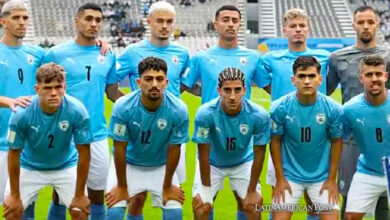7 works that show the fanaticism of composers for football
Throughout the 20th and 21st centuries composers from all over the world created works with soccer as the main theme

We present you a selection of compositions created with football as the main theme. / Photo: youtube.com/Pathé Live
LatinAmerican Post | Luis Hernández Liborio
Escucha este artículo
Leer en español: 7 obras que muestran el fanatismo de los compositores por el fútbol
In music the recurring themes are love, hate, deep dramas, religion, and even war. In appearance, sport has little to do with music, that's why we bring you a small sample of works created around one of the most popular sports: soccer. Artists are often reluctant to glorify sports, it is worth remembering the famous phrase of the writer Jorge Luis Borges about football: "Soccer is popular because stupidity is popular." However, some artists are openly football lovers without having diminished their creative capacity or the quality of their work.
Dmitri Shostakovich playing football with his son. pic.twitter.com/eTFPiIEVln
— composers doing normal shit (@NormalComposers) February 3, 2019
These are some works created by 20th and 21st century composers where soccer is the main theme or source of inspiration, including two composers from Latin America, a region where it is indisputably the reigning sport.
The Golden Age by Dimitri Shostakovich
During the Cold War the world was ideologically divided between communism and capitalism, where there were numerous restrictions and battles in different fields and disciplines: art, weapons, science, space and, of course, sport. Curiously, the Soviet Union was not a power in soccer and the United States was not interested in it. Despite that, this did not prevent it from being a popular sport among the Soviets like the composer Dimitri Shostakovich. The Golden Age (1929) is a play where a Soviet soccer team has to play against a foreign one, of course fascist. Then the play becomes a fight that goes beyond sport, with characters that the Ballet Dance site classifies as picturesque: Soviet players, workers, a black boxer, Nazis and corrupt politicians. It was later adapted as a ballet in the 80s at the Bolshoi Theater. In this fragment we hear the tango that is part of The Golden Age.
Galatasaray Symphony by Kamran Ince
According to the composer's website, the Galatasaray Symphony was composed as a commission for the centenary of the Turkish club, one of the most important in that country. Kamran Ince describes the history of the club from its origins in 1905 through the fall of the Ottoman Empire and the birth of Turkey to its great achievements at the European level in the early 21st century. The composer translates this story and emotions into sounds with moments closer to the spiritual and reflective, but also festive and victorious. Here we have the third movement of this work.
World 78 by Ástor Piazzolla
World 78 is not actually a song, but several contained within an album whose composition was made on the occasion of the 1978 World Cup held in Argentina. According to his grandson, Daniel Piazzolla, Ástor became a follower of the Rivel Plate for him because the composer was not a big fan of this sport. According to Radio Nacional, the original titles of the works were allusive to football: Penalty, Goal or Champion are examples of this. However, the ravages of the brutal ruling dictatorship in Argentina caused Piazzolla to change his mind by changing the album's title to Chador and removing football-related names from the works. Here we hear Criminal .
You can also read: Marcos Mundstock highlights with Les Luthiers
The Silver Tassie by Mark-Anthony Turnage
Harry Heegan is the protagonist of this story that is located in the actions of the First World War. Heegan is a renowned footballer who must suddenly abandon his family and girlfriend to go to the forefront of the war where he is injured according to Schott Music. His best friend rescues him and when he recovers he realizes that he has lost the mobility of his legs and that the woman he loved is now with the man that saved him, a real drama.
Ínguesu by Enrico Chapela
Mexico is one of the eternal aspirants to win the World Cup, while that moment comes one of its greatest achievements so far is having won the 1999 Confederations Cup. In the final, the Mexicans faced Brazil in a fast-paced game, where the Americans were victorious on the field of the Azteca Stadium. The composer Enrico Chapela recovers this accumulation of emotions in Ínguesu , a work that describes the actions of the match through sounds. The result reproduces the atmosphere of a stadium along with the rhythms and melodic motifs that appear in it, as he assures on his page. In addition to the sound part, the composer also cares about live performance, where one of the "players" is expelled from the stage with a red card, among other actions.
The Berserking by Jules McMillan
A return match in 1989 between Celtic and Partizan ended in a (soccer) disaster for the Scots, despite the fact that they got 6 goals, Partizan took the series with away goals. This was the initial inspiration that Jules McMillan took as the basis to compose his Concerto for piano and orchestra The Berserking , where the composer assures that it was the defeat of his team that motivated him to write it. In this regard he commented: "It is possibly the only piece in the history of music that was inspired by the away goal," according to the Scottish BBC .
Barlinnie Nine by Osmo Tapia Räihälä
Duncan Ferguson marked an era in teams like Everton, being also known for his aggressiveness on the court. Finnish composer Osmo Tapia Räihälä decided to create this symphonic poem as a portrait of Ferguson. The title alludes to the Barlinnie prison where Ferguson was held for a few weeks, being a kind of tribute by the composer to the life of the footballer. According to The Sun , Tapia Räihälä's main source of inspiration was the personal contradictions of Ferguson, who showed an aggressive side and a more human side, which is demonstrated, according to the composer, in the fact that Ferguson owned pigeons.




